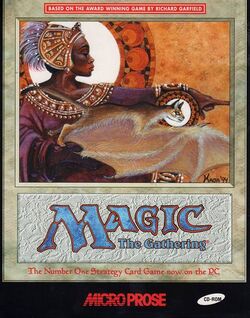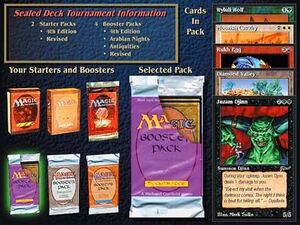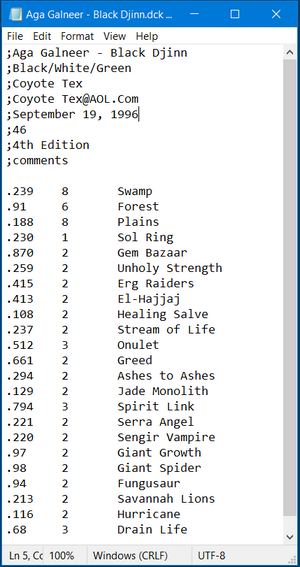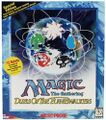Magic: The Gathering (MicroProse)

Magic: the Gathering, also referred to as Shandalar, is a computer game written by MicroProse. It was first released in April 1997.[1]
Releases
Original game
The Windows 95 version of April 1997 replaced the previously announced MS-DOS version. Aside from random duels against the computer using customizable decks, the game features an enhanced campaign mode set on the plane of Shandalar, a deck builder, and a multimedia tutorial. 465 cards were included, taken almost exclusively from Fourth Edition, with a few extremely rare and famous cards from previous sets (Limited Edition and Arabian Nights) thrown in.
Spells of the Ancients

In September 1997, an expansion set called Spells of the Ancients was released, which increased the card pool by 92 cards taken from Arabian Nights and Antiquities. Additionally, it added a sealed deck generator.
Duels of the Planeswalkers
In February 1998, the main game was rereleased in a special edition named Duels of the Planeswalkers. The card pool was increased by 385 cards, incorporating cards from Legends as well as filling in cards not supported in previous releases. Furthermore, it included an option named ManaLink to allow play against other players online.
For players who had purchased earlier versions of the game, ManaLink was made available through a downloadable patch, allowing those players to play online as well.[2]
Gold Edition
In August 1999, Hasbro announced its plans to ship a new version of the game, called Gold Edition, in the fall.[3] It would have included play against AI, multiplayer either over LAN or via the Internet, further additional cards from Legends and The Dark, and new features such as sideboarding.
Gold Edition was never released. MicroProse ceased to exist in January 2001.
Unofficial 2010 Edition
A devout fan community updated the game to run on Windows 7 (or newer), with the last version being the 2010 edition. This version supports larger screen resolutions, a larger maximum number of cards, and other fixes. Cards are added from sets ranging from Ice Age to Conflux, but like the original game, no complete sets. See external links for the community forum and download links.
Characters
Bosses
Dragons
Djinns
Dual Color
Black
White
-
Arch Angel
Blue
-
Merfolk Shaman
Green
Red
Card pool
Astral set
Part of the original Magic: The Gathering game is a "semi-expansion" of 12 cards, known as Astral. The Astral cards have a unique set symbol (), and incorporate various random attributes that would be difficult or impossible to replicate in real life.[4] While most of these cards exist only within this game, the first 50,000 boxes published contained an oversized version of the card "Aswan Jaguar", which has the MicroProse logo printed between the name and cost.
| # | Cardname | Cost | Type | Text | P/T |
|---|---|---|---|---|---|
| 1 | Aswan Jaguar | Summon Jaguar | When Aswan Jaguar comes into play, choose a random creature type from those in target opponent’s deck. |
2/2 | |
| 2 | Call from the Grave | Sorcery | Put a random creature from a random graveyard into play under your control. Call from the Grave deals to you an amount of damage equal to that creature's casting cost. | ||
| 3 | Faerie Dragon | Summon Dragon | Flying |
1/3 | |
| 4 | Goblin Polka Band | Summon Goblin | 1/1 | ||
| 5 | Necropolis of Azar | Enchantment | Whenever a non-black creature is put into any graveyard from play, put a husk counter on Necropolis of Azar. |
||
| 6 | Orcish Catapult | Instant | Randomly distribute X −0/−1 counters among a random number of random target creatures. | ||
| 7 | Power Struggle | Enchantment | During each player's upkeep that player exchanges control of random target artifact, creature, or land he or she controls, for control of random target permanent of the same type that a random opponent controls. | ||
| 8 | Prismatic Dragon | Summon Dragon | Flying During your upkeep, Prismatic Dragon becomes a random color permanently. |
2/3 | |
| 9 | Rainbow Knights | Summon Knights | When Rainbow Knights comes into play it gains protection from a random color permanently. |
2/1 | |
| 10 | Whimsy | Sorcery | Play X random effects. | ||
| 11 | Pandora's Box | Artifact | |||
| 12 | Gem Bazaar | Land | When Gem Bazaar comes into play, choose a random color. |
-
Oversized Aswan Jaguar card
-
Whimsy
Preconstructed Decks

There are 55 enemy characters in the Shandalar game, each of which has its distinct deck. Enemies can be grouped into twelve separate tiers with the same starting life total, cost to bribe (a payment of in-game currency to skip the match), and approximate deck strength[5]. All decks were designed by Micropose Designer and Producer Coyote Tex.[6]
The two expansions, Spells of the Ancients and Duels of the Planeswalkers both had variations of each enemy decklist. Since they could be installed separately, cards added for Spells were removed for Duels. The latter generally were very similar to their respective decklist in the base game, with the main differences resolving from the expansion not using the game's sideboarding mechanic.
The Duels expansion also included a number of extra decklists which users could play. They weren't automatically available in the game: users would need to open the game's files and move them into a different directory.
Trivia
- The game features an MTG tutorial video in which a young Rhea Seehorn (aka Kim Wexler from Better Call Saul) acts as one of the teachers.[7][8]
- Call from the Grave was reprinted as a test card in Mystery Booster 2.
Gallery
-
Cover of initial release v.3 of the game
-
Back side of all 3 releases of the game
-
Cover of expansion
-
Limited Edition
-
Cover of the 1998 re-release
-
Manalink advertisement
References
- ↑ Michael G. Ryan (2009-06-01). "A Magic History of Time". magicthegathering.com. Wizards of the Coast. Archived from the original on 2021-04-14.
- ↑ https://web.archive.org/web/19990503041426/http://gathering.net/downloads.html
- ↑ Wizards of the Coast (August 1999). Hasbro announces a new version of the Magic computer game. Duelist #40
- ↑ Wizards of the Coast (February 12, 2009). "Astral Cards". magicthegathering.com. Wizards of the Coast.
- ↑ Erik. "Magic the Gathering - Microprose Shandalar (website)". dos486.com. Retrieved on February 14, 2025.
- ↑ CoyoteTex (June 04, 2022). "Hello from the Designer of the original Shandalar game (forum post)". Collectable Card Games Headquarters. slightlymagic.net. Retrieved on February 14, 2025.
- ↑ Jody Macgregor (2022-02-11). "The first digital deck builder was a Magic: The Gathering game from 1997 and it ruled"
- ↑ MobyGames (2022). "Magic: The Gathering Credits"






























































